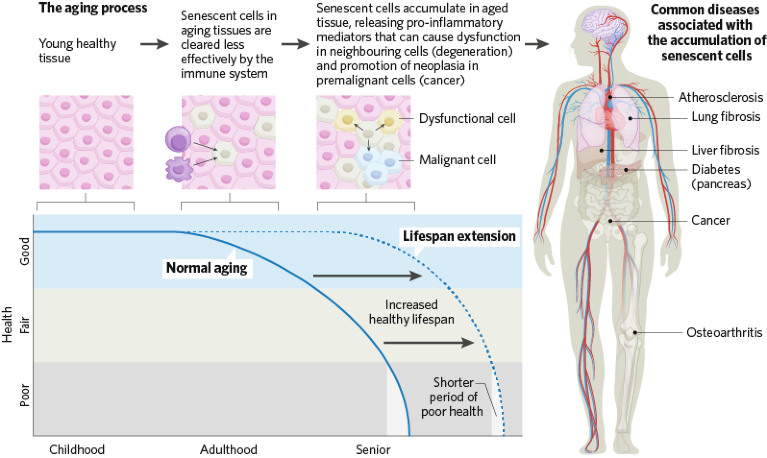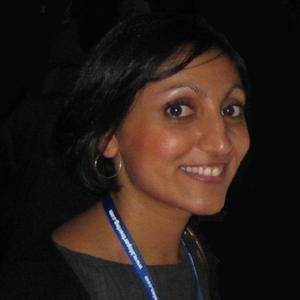Delaying aging, restoring youth, regenerative medicine… whatever term is used, research aiming to target fundamental mechanisms of aging to increase life expectancy and quality has flourished in recent years.
Ten years ago, Lopez Otin and colleagues wrote a review that described hallmarks of aging, including genomic instability, stem cell exhaustion, deregulated nutrient sensing, mitochondrial dysfunction, and cellular senescence1. Among efforts to target these hallmarks with potential therapies, those focused on cellular senescence have been at the forefront of industry activity, with more than 20 companies established in the past decade2. In this piece, we highlight some of the progress and challenges for a selection of these companies.
Clearing out the zombies
Over time, processes such as DNA damage, infection, and oxidative stress can lead to cells not functioning properly, but also not dying as they should and instead remaining in a zombie-like state. It is thought that these damaged cells, known as senescent cells, enter this state as a way of not becoming cancerous, but this also has a downside. The senescent cells can accumulate in various tissues and organs, and they are not just passive clutter—they secrete pro-inflammatory molecules such as cytokines, chemokines, growth factors, and proteases.
The phenomenon is known as the senescence-associated secretory phenotype (SASP) and leads to an inflammatory environment that can result in chronic tissue damage and contributes to a range of diseases (Fig. 1), including liver and lung fibrosis, atherosclerosis, diabetes, and osteoarthritis3. Consequently, these cells have become a target for the development of anti-aging therapeutics. Among the companies exploring this approach, some are developing senolytic drugs that directly target senescent cells, while others are manipulating mechanisms that modulate senescent cells.

Fig. 1 | The role of senescent cells in aging and disease development. Senescent cells accumulate in various tissues with age. They have a senescence-associated secretory phenotype (SASP) that is characterized by the secretion of pro-inflammatory mediators such as cytokines, chemokines, and growth factors, which is thought to have an important role in multiple age-related diseases (right).
One of the longest-established companies, Unity Biotechnology, was founded in San Francisco in the United States (US) in 2011 by academic leaders in the field including Jan van Deursen at the Mayo Clinic, US, and Judith Campisi at the Buck Institute for Research on Aging, Novato, California, US, and is backed by high-profile investors such as Jeff Bezos and Peter Thiel (Table 1). The company is focused on developing small-molecule drugs that clear senescent cells in diseased tissues, achieving this by targeting pathways involved in apoptotic cell death that have also been pursued to kill cancer cells.
Unity’s original lead candidate, UBX0101, was a small-molecule inhibitor of MDM2 designed to boost the activity of the pro-apoptotic protein p53. However, its development was abandoned in 2020, when it failed to surpass a placebo in reducing joint pain and stiffness in a phase 2 trial involving patients with osteoarthritis of the knee. The results cast a pall over the senolytics field, but with researchers noting various potential reasons for failure including a sub-optimal biological target, a compound with weak senolytic activity and a high placebo response2, the company has regrouped and persisted.
Unity is now developing UBX1325, a potent small-molecule inhibitor of the anti-apoptotic protein BCL-XL, on which senescent cells rely to survive. Unity accessed the compound through a collaboration established in 2016 with the China-based biopharma company Ascentage Pharma, and it is currently in phase 2 trials for the treatment of age-related diseases of the eye. In April 2023, Unity announced positive top-line results from a phase 2 study of UBX1325 in patients with diabetic macular edema, showing improvements in visual acuity over 48 weeks following a single intravitreal injection of the compound.
Another senolytic approach that has reached clinical trials is treatment with the combination of dasatinib, an approved anticancer drug that targets multiple kinases, and quercetin, a flavonoid that is found in fruit skin. The ‘D+Q’ combination has been shown to selectively clear senescent cells in animal models and humans, and a phase 2 trial known as SToMP-AD to assess the combination in patients with mild cognitive impairment or early-stage Alzheimer’s disease was started in 2021. A phase 1 trial supporting the combination’s safety and tolerability was published earlier this year4.
At the preclinical stage, Seattle, US-based Oisin Biotechnologies, established in 2014, is targeting senescent cells through p16, a protein involved in cell cycle regulation that is highly expressed in senescent cells5. The company has developed a platform based on a gene therapy technology that uses a DNA construct to deliver an exogenous pro-apoptotic gene, caspase 9, to p16-positive cells only, instructing them to commit suicide and thereby clearing senescent cells while leaving normal cells unharmed.
Another preclinical-stage company, California-based Deciduous Therapeutics, is harnessing an immunological approach to reduce the number of senescent cells: reactivating endogenous immune surveillance mechanisms to remove them. Research by a team including the company’s co-founder, Anil Bushan, found that alpha-galactosylceramide can activate invariant natural killer T cells (iNKT) cells and hence reduce the number of senescent cells in animals. Published results show that this approach can clear senescent cells in adipose tissues in obese mice, thereby improving glucose control, and clear senescent cells in the lung in a mouse model of lung injury, decreasing fibrosis and improving survival6.
As such companies progress with their diverse approaches to target senescence, they will encounter the challenges of running pivotal trials that contributed to the failure of Unity Biotechnology’s pioneering program, including identifying a suitable indication where their drugs result in meaningful improvements in a clinical endpoint that could provide the basis for approval. As the momentum and investment in the field of aging builds though, it is becoming increasingly likely that a breakthrough candidate will emerge. If so, there will be intense competition from larger companies to gain access to therapeutics that may indeed turn back the clock on aging.
Table 1 | Selected companies targeting senescent cells
Company |
Location |
Therapeutics and platforms in development |
|---|---|---|
Unity Biotechnology |
California, United States |
Small molecule UBX1325, in phase 2 development for age-related diseases of the eye. |
Oisin Biotechnologies |
Seattle, United States |
SENSOlytics platform technology targeting diseases including chronic kidney disease. |
Deciduous Therapeutics |
California, United States |
Preclinical candidates that activate an immune surveillance mechanism to treat age-related diseases. |
Cleara Biotech |
Utrecht, the Netherlands |
Anti-senescence compounds CL04177 and CL04183 in preclinical development for the treatment of metastatic colon cancer and triple-negative breast cancer. |
Rubedo Life Sciences |
California, United States |
RLS-1496, which targets senescent cells in the skin, in preclinical development for dermatological conditions. |
Senisca |
Exeter, United Kingdom |
Preclinical candidates including oligonucleotides and small molecules to reverse senescence through modulation of RNA splicing for the treatment of multiple age-related diseases. |
Etta Biotechnology |
California, United States |
Preclinical candidate for kidney disease generated using the artificial intelligence-driven SenoSmart platform. |


